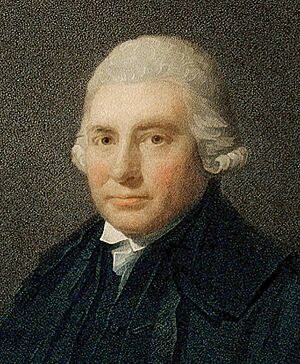Alexander Monro Secundus facts for kids
Alexander Monro (born May 22, 1733 – died October 2, 1817) was a Scottish doctor and teacher. He was an expert in anatomy, which is the study of the body's structure. People often call him Alexander Monro Secundus (meaning "the second") or Junior. This is because he was the second of three doctors in his family with the same name.
Monro Secundus made important discoveries. He helped describe the lymphatic system, which is part of your body's defense against germs. He also created very detailed descriptions of the muscles and bones. He was important for bringing clinical medicine (learning by seeing and treating patients) into medical school lessons. He is also known for the Monro–Kellie doctrine. This is an idea about pressure inside the head, which he developed with his student, George Kellie.
Contents
A Young Doctor's Life
Alexander Monro was born in Edinburgh, Scotland, on May 20, 1733. He was the youngest son of Isabella Macdonald and Alexander Monro Primus, who was also a famous doctor.
Early School Days
Alexander went to Mr. Mundell's school with his brothers. There, he learned Latin and Greek. Even as a young boy, he showed he was very smart and talented.
University and Medical Training
When Alexander was 12, his father decided he would follow in his footsteps. So, Alexander went to the University of Edinburgh. He studied math and ethics before starting his medical training at age 18. He loved learning about anatomy and helped his father in the dissecting room. He was very eager to learn and had a great memory.
Becoming a Professor
In 1753, Alexander's father had too many students for his anatomy class. He had to teach the same lesson twice a day. This was hard work. So, he tried having his son, Alexander Secundus, teach the evening class. Alexander did a great job!
Because of this, his father asked the city council to make Alexander Secundus his official successor. On July 11, 1754, Alexander Monro Secundus became a professor alongside his father.
Studying Abroad
Alexander finished his medical degree on October 20, 1755. Then, he traveled to other countries to learn more.
- He spent time in London, learning from William Hunter.
- He visited Paris.
- He went to Leyden University in the Netherlands. There, he became friends with famous anatomists Bernhard Siegfried Albinus and Petrus Camper.
- He studied in Berlin, Germany, with Professor Meckel.
In 1757, he returned to Edinburgh for a short time to teach for his father, who was ill.
Teaching Career
In 1758, Alexander's father gave his anatomy and surgery lectures to his son. Alexander Secundus then taught full courses every year from 1759 to 1800. After 1800, his own son, Alexander Tertius, started helping him teach. Alexander Secundus gave his last lecture in 1808.
Later Years and Legacy
As he got older, Alexander's health slowly declined. He passed away on October 2, 1817. He is buried with his family in Greyfriars Kirkyard in Edinburgh.
Alexander Monro Secundus was a very important figure in medicine. He helped shape how doctors were trained and made big contributions to our understanding of the human body.
Images for kids





